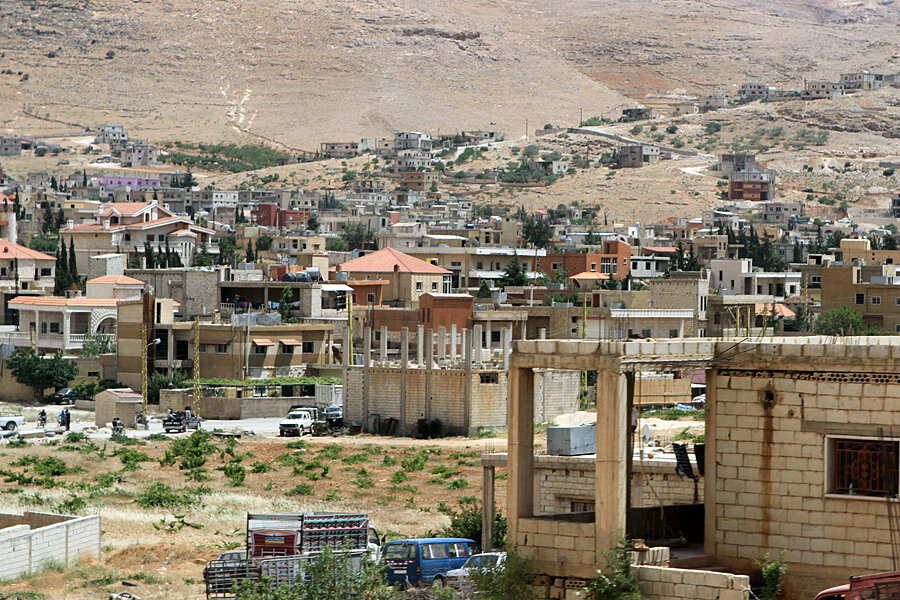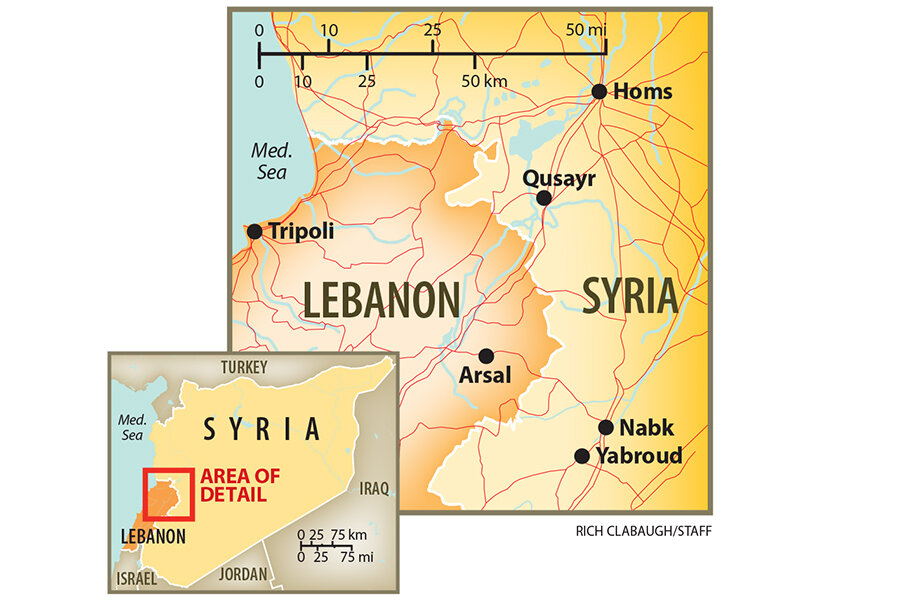As Iraqi conflict flares, Syrian rebels regroup in Lebanon
Loading...
| Arsal, Lebanon
Renewed fighting in Syria’s strategic Qalamoun region north of Damascus threatens to spill across the border into Lebanon, where thousands of Syrian rebels have been holed up in recent months.
An estimated 3,000 to 4,000 rebel fighters are using the rugged mountains east of this town as a staging ground to launch hit-and-run attacks against Syrian regime positions. Their objective is to degrade the Syrian Army and its allies and to divert resources from other battlefronts around Damascus.
While the world watches the growing unrest in Iraq, the conflict next door in Syria continues to burn, roiling neighbors like Lebanon and Israel. On Monday, Israel carried out airstrikes against Syrian regime targets in retaliation for a cross-border attack in the Israeli-occupied Golan Heights. Late Monday, a suicide car bomber in Lebanon struck a cafe in a Shiite neighborhood, causing several casualties. (Read a special report from Arsal here.)
As the boundary between Syria and Iraq further dissolves amid an offensive by the Islamic State of Iraq and the Levant (ISIS), a pan-national Sunni extremist group, this remote piece of the Syria-Lebanon border – another legacy of the post-Ottoman order – is also becoming increasingly irrelevant. Syrian anti-regime rebels and militants from Lebanon's Shiite Hezbollah are battling each other on both sides of the border.
The rebels fighting in Qalamoun, which bisects the strategic Damascus-Homs highway, belong to groups like the Free Syrian Army, the Tawhid Brigade, and Jabhat al-Nusra, Syria’s Al Qaeda affiliate.
“We are using hit-and-run tactics now to wear down the enemy in Qalamoun and relieve pressure on other fronts such as Mleiha,” says Abu Zeid, a unit leader in the moderate rebel Muatassim Billah Brigade, referring to a besieged rebel-held town east of Damascus. “We hit two or three positions over a couple of days, then we retreat back into Lebanon.”
On June 11, Lebanon-based rebels launched a counter-attack on the town of Rankous and two nearby villages in Qalamoun, all less than five miles from the Lebanese border. Rankous had fallen to the regime in early April at the climax of a five-month Qalamoun offensive led by Hezbollah, a key ally of Syrian President Bashar Assad's regime.
The rebel counter-attack on the Rankous area had been planned for some time, according to Abu Zeid, but was aided by the recent departure from the area of Iraqi Shiite paramilitary forces allied to the Assad regime. They went back to Iraq to join the fight against a spreading Sunni rebellion.
Abu Zeid participated in the initial attack on Rankous, leading his 15-man unit against a regime position on a steep hill outside the town. The position was defended by Syrian soldiers and fighters from the National Defense Force, an Iran-trained militia whose personnel are mainly Alawites, the splinter sect of Shiite Islam to which Mr. Assad belongs.
“We attacked from three sides,” Abu Zeid says, speaking at a friend’s house in Arsal during a rare trip to the town. “The [NDF] militiamen ran away when they heard the first explosion but it took us three hours to capture the post. We lost three men and 20 wounded. If the post had been on flat ground we would have taken it in 10 minutes.”
An array of enemies
Before the conflict broke out in March 2011, Abu Zeid, a stocky man with a graying beard, was a farmer from the town of Qusayr, just over the border in Syria. Since then he has fought in the area against an array of enemies, including the Syrian Army, Alawite militiamen, and Hezbollah fighters.
“Hezbollah are very strong, tough fighters,” he says. “They have experience, quality weapons and tactics. Syrian soldiers and Defense Force [NDF] militiamen will drop their weapons and run away, but not Hezbollah.”
Now he stays with other fighters in barren limestone mountains east of Arsal and the neighboring village of Ras Baalbek five miles to the north, living in caves and abandoned farmsteads.
Over the weekend, Syrian Army troops and Hezbollah fighters struck back in the Rankous area. Syria’s state-run television said on Sunday that the Army had recaptured some hills overlooking Rankous “and are pursuing terrorist groups who tried to infiltrate the region from Lebanon."
“This land will be a cemetery for all terrorists who decide to return,” a Syrian Army officer was quoted as saying.
Fighting spillover
The fighting has already spilled into Lebanon: the village of Tufayl, which sits at the tip of a narrow peninsular of territory poking eastward into Syria, has been shelled in recent days. Many residents have fled over desolate mountains to reach Arsal, 25 miles to the north. Their village is accessible via a 13-mile dirt track that is controlled at the western end by Hezbollah.
“A month ago Hezbollah was seven miles to the west of the village. Now they are less than two miles,” says Sheikh Hussein Ghali, a Sunni cleric who has been pressing the Lebanese government to provide assistance to the beleaguered village.
According to a veteran Hezbollah fighter who has served several tours in Syria, the group is determined to drive the rebels out of their Lebanese hideouts. “Let them [the rebels] be as strong as they want. If our missiles don’t kill them then they will die from Syrian air strikes,” the Hezbollah fighter says.
Syrian aircraft have repeatedly bombed rebel areas near Arsal inside Lebanon and there is little to stop a cross-border ground incursion by Syrian troops.
The Lebanese Army is deployed in Arsal but so far has not ventured deeper into the mountains where the well-armed rebels are bunkered, though it has announced plans to build forward operating bases there in the hope of better controlling the area.
For now, a wary standoff exists between Hezbollah, the Lebanese Army, and rebel groups. Abu Zeid says the rebels in the mountains are braced for an assault by invading Syrian troops and Hezbollah.
“We are expecting the Syrians to come to us. When they come, we will count on our strength in battle and on God,” he says.








